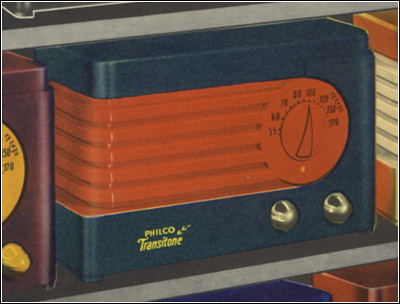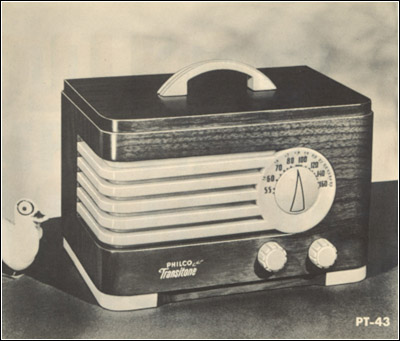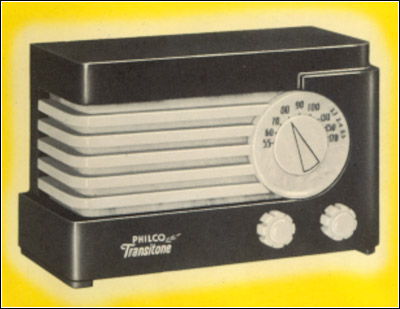Of Old Radios And Related Items--Published Monthly
Philco Dealer Poster and the PT-10C
By Mike Masar
Web Edition
Radios in colorful cabinets have been the subject of several articles in A.R.C. But, Philco may be the king of color in terms of variety, as Mike Masar explains in this article. (Editor)
I enjoyed reading Phil MacArthur's story "Flavoradios Become More Flavorful" in the March 2008 issue about the many colors of Flavoradios. However, his statement that the eleven colors he has discovered "Probably setting a record for the largest color variety of any radio ever made" got me thinking about an old Philco poster I thought I remembered having somewhere.
Sure enough, a little digging turned up a Philco dealer poster announcing the radio lineup for the 1940 model year. A section of the poster described the 5- Loktal tube, Transitone Model PT-10C priced at $14.95. Figure 1 shows a Model 10C image extracted from the poster photo on this month's cover. What astounded me was the number of color combinations offered -- fifty-five! Sure makes eleven seem puny.
The poster advises you to contact your distributor for a list of colors, but no mention is made of the actual number of basic colors available, or how fifty-five color combinations could be achieved. Why so many colors? The poster touted that the variety was "Philco's answer to the growing demand for radios that will harmonize with the colorful decorative schemes of today." This statement would seem to coincide with the movement toward color in other products, such as cars.
Figure 1. The Philco Model PT-10C, priced at $14.95 and available in 55 color combinations!
Figure 2. The Philco Model PT-43 had a rich walnut cabinet with handle, dial, knobs, and speaker grille in cream plastic.The poster tries to entice you with other reasons for multiple colors, such as "To suit the decorative scheme of any home or office" and "To fill the student demand for a radio finished in school, college, club, fraternity and sorority colors."
Although my wife would have you believe that I already own too many Philco radios, I do not own a PT-10C. In fact, I'm not sure I have ever seen one, which leads me to believe they are very rare, especially for a major national brand. The body and louver area appear to be made out of the same plastic type material. Were the same color choices available for both areas, and how many different base colors were there? I wonder how many different color combinations were actually sold.
I'd be interested to know if anyone has any more information on this radio or if anyone actually owns one. If so, is it in your fraternity colors?
Similar Philco Transitones
Philco produced several other sets in the same style as the PT-10C, as indicated in another part of the Philco poster for the 1940 model lineup. However, none could match the PT-10C in variety of color.
Most were in darker tones of brown and ebony. For example, the PT-43, shown in Figure 2, was advertised as "Refreshingly different!" It had a rich walnut cabinet with handle, dial, knobs, and speaker grille of cream plastic. The PT-55, shown in Figure 3 (see print version), had a rich brown and amber plastic cabinet and carrying handle. It was touted as "Bound to be a favorite!" The PT-35, shown in Figure 4, might have had even more eye-appeal with its gleaming ebony cabinet and dial, knobs, and speaker grille in contrasting cream.
Figure 4. The Philco PT-35 had great eye-appeal with its bright ebony cabinet and dial, knobs, and speaker grille in contrasting cream.Models with electric push-button tuning like the PT-59, shown in Figure 5 (see print version), and the PT-67 are described as having a more "distinctive modern design." The PT-59 has a two-tone brown and amber plastic cabinet, while the PT-67 is "a beauty" in amber and brown plastic with a molded handle.
In all, Philco advertised 21 Transitone models. All are described in the poster as "Powerful AC-DC superheterodynes, with 5 super-efficient Loktal tubes...all working -- no ballast tubes. And they have Automatic Volume Control, High-Output Speaker, Full-Vision Dial. All approved by Underwriters' Laboratories -- Safe from fire and shock."
Obviously, Philco could easily fill its promise of providing a radio to suit the needs and decor of any home or office.
Mike Masar has worked as an electrical engineer in the paper industry for 30 years. His radio collecting began in 1985 when his wife bought him a console for 50 cents at auction with the stipulation that she take along a second console for free.
|
[Free Sample] [Books, etc., For Sale] [Subscribe to A.R.C./Renew] [Classified Ads] [Auction Prices] [Event Calendar] [Links] [Home] [Issue Archives] [Book Reviews] [Subscription Information] [A.R.C. FAQ]URL = http://www.antiqueradio.com/Nov08_Masar_Poster.html Copyright © 1996-2008 by John V. Terrey - For personal use only. Last revised: October 30, 2008. For Customer Assistance please contact ARC@antiqueradio.com or call (866) 371-0512 toll free Pages designed/maintained by Wayward Fluffy Publications Antique Radio Classified |


